AMD Radeon HD 7790 Review Feat. Sapphire: The First Desktop Sea Islands
by Ryan Smith on March 22, 2013 12:01 AM EST- Posted in
- GPUs
- AMD
- Sapphire
- GCN
- Radeon HD 7000
Compute Performance
As always we'll start with our DirectCompute game example, Civilization V, which uses DirectCompute to decompress textures on the fly. Civ V includes a sub-benchmark that exclusively tests the speed of their texture decompression algorithm by repeatedly decompressing the textures required for one of the game’s leader scenes. While DirectCompute is used in many games, this is one of the only games with a benchmark that can isolate the use of DirectCompute and its resulting performance.
Our next benchmark is LuxMark2.0, the official benchmark of SmallLuxGPU 2.0. SmallLuxGPU is an OpenCL accelerated ray tracer that is part of the larger LuxRender suite. Ray tracing has become a stronghold for GPUs in recent years as ray tracing maps well to GPU pipelines, allowing artists to render scenes much more quickly than with CPUs alone.

Our 3rd benchmark set comes from CLBenchmark 1.1. CLBenchmark contains a number of subtests; we’re focusing on the most practical of them, the computer vision test and the fluid simulation test. The former being a useful proxy for computer imaging tasks where systems are required to parse images and identify features (e.g. humans), while fluid simulations are common in professional graphics work and games alike.

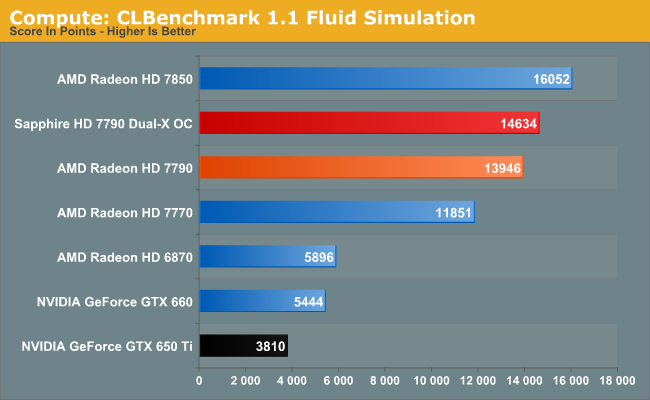
Moving on, our 4th compute benchmark is FAHBench, the official Folding @ Home benchmark. Folding @ Home is the popular Stanford-backed research and distributed computing initiative that has work distributed to millions of volunteer computers over the internet, each of which is responsible for a tiny slice of a protein folding simulation. FAHBench can test both single precision and double precision floating point performance, with single precision being the most useful metric for most consumer cards due to their low double precision performance. Each precision has two modes, explicit and implicit, the difference being whether water atoms are included in the simulation, which adds quite a bit of work and overhead. This is another OpenCL test, as Folding @ Home is moving exclusively OpenCL this year with FAHCore 17.
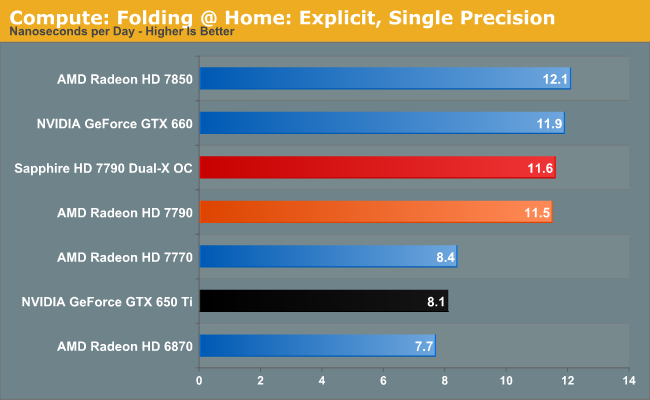
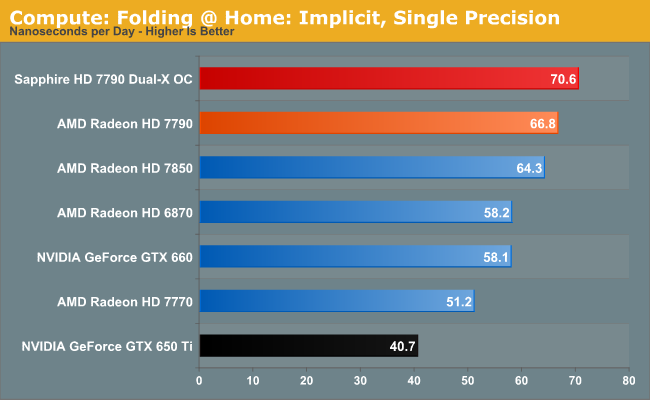
Our 5th compute benchmark is Sony Vegas Pro 12, an OpenGL and OpenCL video editing and authoring package. Vegas can use GPUs in a few different ways, the primary uses being to accelerate the video effects and compositing process itself, and in the video encoding step. With video encoding being increasingly offloaded to dedicated DSPs these days we’re focusing on the editing and compositing process, rendering to a low CPU overhead format (XDCAM EX). This specific test comes from Sony, and measures how long it takes to render a video.
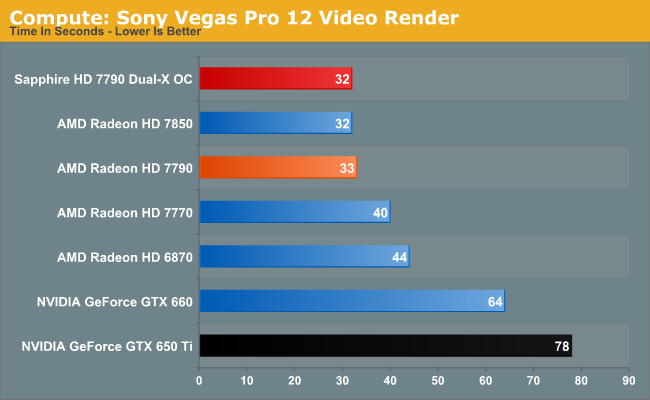
Wrapping things up, our final compute benchmark is an in-house project developed by our very own Dr. Ian Cutress. SystemCompute is our first C++ AMP benchmark, utilizing Microsoft’s simple C++ extensions to allow the easy use of GPU computing in C++ programs. SystemCompute in turn is a collection of benchmarks for several different fundamental compute algorithms, as described in this previous article, with the final score represented in points. DirectCompute is the compute backend for C++ AMP on Windows, so this forms our other DirectCompute test.
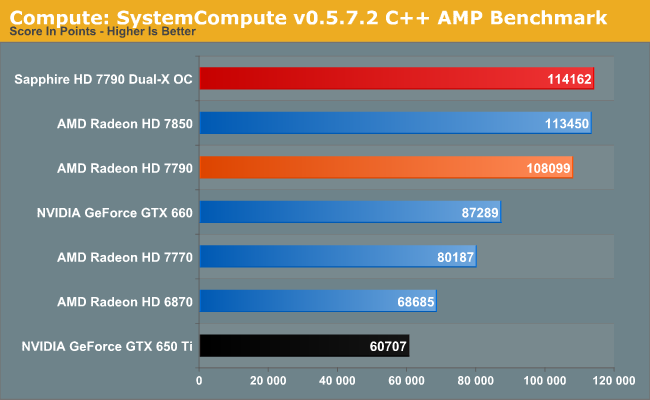


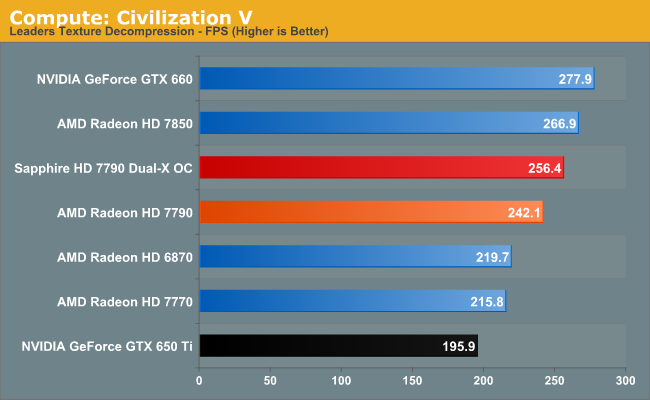








107 Comments
View All Comments
silverblue - Friday, March 22, 2013 - link
Not at 176GB/s, unless they're clocking that GDDR5 VERY high. The 7790 is good for 96GB/s.Shut up and drink - Friday, March 22, 2013 - link
Sony's previous two consoles (PS2 and PS3)have traditionally favored high frequency/bandwidth proprietary Interconnects between components (see Cell's EIB) so this is likely where the "secret sauce" Sony R&D came in, thus facilitating the 176GB/S.AMD was quoted (can't find link) that said Sony engineering would be excluded if/when they release a PC variant of said APU.
Spunjji - Friday, March 22, 2013 - link
Very, very interesting indeed. It tallies well with the numbers. There was me thinking they had bolted Pitcairn onto the side of their CPUs but this combo might make more sense (and yet also less sense).lopri - Friday, March 22, 2013 - link
Totally agree with memory size. At this performance and price level, 2 GB should be default.lopri - Friday, March 22, 2013 - link
Then again, it would be strange if AMD doesn't release "larger" cards based on this updated GCN core.silverblue - Friday, March 22, 2013 - link
Perhaps the reason for the lack of a 2GB version would be that it would be too close to the 7850...?CeriseCogburn - Sunday, March 24, 2013 - link
NO it SLOWS THE CARD DOWN with it's crappy amd core...Haven't you been paying attention for like the YEARS you've been here ?
My apologies if you're an epileptic.
Tams80 - Monday, April 1, 2013 - link
I don't understand why you haven't been banned yet. You add nothing to the discussion with your posts other than vitriol. Please either be civil and logical, or go away.CeriseCogburn - Sunday, March 24, 2013 - link
AMD always releases 1GB models and 2GB models so the amd fanboys can quote the 1GB model cheapo powercolor low end price, claim it wins price perf, then go on raging about how the 2GB model covers the high end ...ROFL - That's what they do - they even do it when comparing to a 2GB nVidia, suddenly forgetting amd makes crapster 1GB they swore off years ago, even though that's the screamer amd fanboy price "they pay" because "it's such a deal! Man! "
Brainfart Bart they should be called.
R3MF - Monday, March 25, 2013 - link
Actually, they didn't with the 7770.Your constant whining is about as welcome as a bout of herpes, scram.